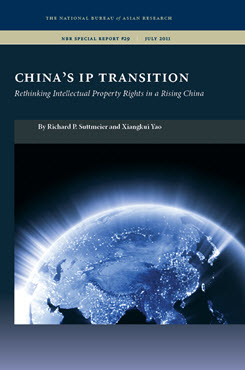NBR Special Report no. 29
China's IP Transition
Rethinking Intellectual Property Rights in a Rising China
China’s drive to promote indigenous innovation has given intellectual property (IP)—its creation, utilization, management, and protection—a prominent position in the nation’s policy agenda.
EXECUTIVE SUMMARY
MAIN ARGUMENT
In conjunction with its ambitious policies to support indigenous innovation, China launched a major IP strategy in 2008 to support the creation, utilization, management, and protection of IP. The implementation of the strategy comes at a time when the population of scientists, engineers, entrepreneurs, designers, and others in the cultural and creative industries who have a stake in a more robust national IP regime is expanding. The experience of other countries would suggest that China is therefore poised to make a transition to a national IP regime that is more in harmony with international norms. Yet the development of the IP system at times fits awkwardly with other indigenous innovation policies. This essay explores the factors shaping the evolution of China’s IP regime and argues that, while movement toward greater harmonization with international IP norms is evident, the direction is by no means assured.
POLICY IMPLICATIONS
- More attention should be given to understanding the links between China’s R&D system and the evolving IP regime, the development of corporate IP strategies among Chinese firms, the actions of local governments in promoting the IP strategy, the emergence of IP brokers, and the development of specialized markets for IP. This requires not only better eyes and ears on the ground in China, and a greater recognition of China’s regional and other differences, but also new forms of cooperation between foreign legal communities and specialists on innovation studies.
- Chinese leaders have recently made a number of commitments to the U.S. and other foreign parties to crack down on piracy and reverse industrial policies that seek to use IP in ways that are outside accepted international norms. Foreign stakeholders should continue to engage China on these issues, drilling further down into how these policies are implemented at national and local levels and pressing for the full implementation of the commitments Beijing has made.
- Engagement with China on its efforts to integrate its IP and innovation strategies should be expanded. The initiation of the “innovation dialogue” within the framework of the Strategic and Economic Dialogue is a useful first step to this end, but the U.S. side should be prepared to commit more staff and analytic resources to this effort in order to engage China from a more informed position.
- A changing IP landscape in China requires that foreign companies rethink their approaches to protecting IP in the country. Many foreign companies have been reluctant to pursue their rights in the Chinese legal setting, but a growing number of IPR specialists now believe that foreign rights holders should register their IP in China and use Chinese IP law more aggressively to protect their interests.



